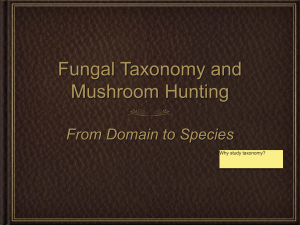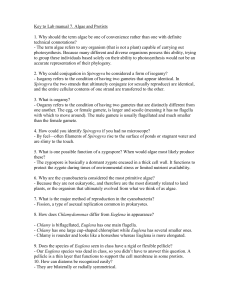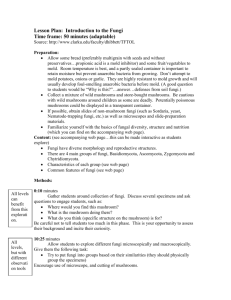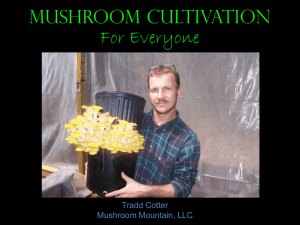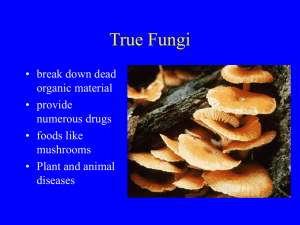B. Lower club fungi
advertisement
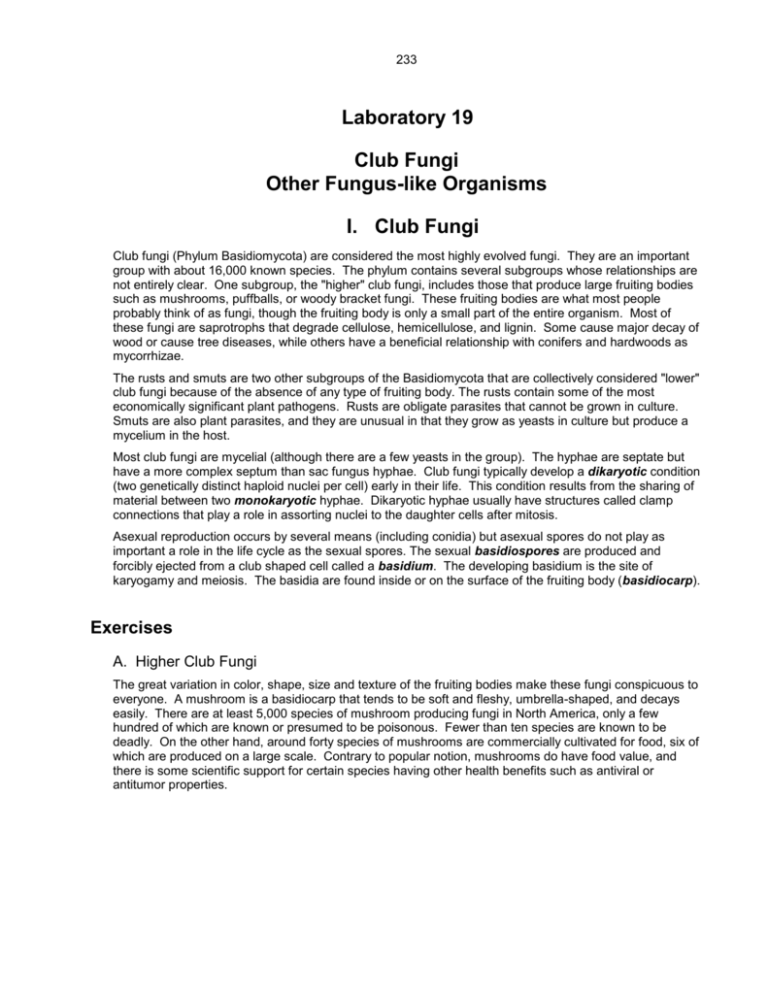
233 Laboratory 19 Club Fungi Other Fungus-like Organisms I. Club Fungi Club fungi (Phylum Basidiomycota) are considered the most highly evolved fungi. They are an important group with about 16,000 known species. The phylum contains several subgroups whose relationships are not entirely clear. One subgroup, the "higher" club fungi, includes those that produce large fruiting bodies such as mushrooms, puffballs, or woody bracket fungi. These fruiting bodies are what most people probably think of as fungi, though the fruiting body is only a small part of the entire organism. Most of these fungi are saprotrophs that degrade cellulose, hemicellulose, and lignin. Some cause major decay of wood or cause tree diseases, while others have a beneficial relationship with conifers and hardwoods as mycorrhizae. The rusts and smuts are two other subgroups of the Basidiomycota that are collectively considered "lower" club fungi because of the absence of any type of fruiting body. The rusts contain some of the most economically significant plant pathogens. Rusts are obligate parasites that cannot be grown in culture. Smuts are also plant parasites, and they are unusual in that they grow as yeasts in culture but produce a mycelium in the host. Most club fungi are mycelial (although there are a few yeasts in the group). The hyphae are septate but have a more complex septum than sac fungus hyphae. Club fungi typically develop a dikaryotic condition (two genetically distinct haploid nuclei per cell) early in their life. This condition results from the sharing of material between two monokaryotic hyphae. Dikaryotic hyphae usually have structures called clamp connections that play a role in assorting nuclei to the daughter cells after mitosis. Asexual reproduction occurs by several means (including conidia) but asexual spores do not play as important a role in the life cycle as the sexual spores. The sexual basidiospores are produced and forcibly ejected from a club shaped cell called a basidium. The developing basidium is the site of karyogamy and meiosis. The basidia are found inside or on the surface of the fruiting body (basidiocarp). Exercises A. Higher Club Fungi The great variation in color, shape, size and texture of the fruiting bodies make these fungi conspicuous to everyone. A mushroom is a basidiocarp that tends to be soft and fleshy, umbrella-shaped, and decays easily. There are at least 5,000 species of mushroom producing fungi in North America, only a few hundred of which are known or presumed to be poisonous. Fewer than ten species are known to be deadly. On the other hand, around forty species of mushrooms are commercially cultivated for food, six of which are produced on a large scale. Contrary to popular notion, mushrooms do have food value, and there is some scientific support for certain species having other health benefits such as antiviral or antitumor properties. 234 1. Mycelium Clamp connections sketch Examine a demonstration slide of mycelium from Pleurotus (oyster mushroom). Look for the clamp connections located at the septa. 2. Fruiting Body (Basidiocarp) a. Examine a fresh fruiting body of a mushroom (common button or portabella, whichever is available). This is the quick-developing, temporary, reproductive part of the fungus produced by a mycelium that extends thorough the soil, wood, or artificial substrate). Identify the cap (pileus) and stalk (stipe). Note the gills on the lower surface of the cap. The stalk may have a ring (annulus). Other species of mushrooms may have a cup-like structure at the base of the stalk called a volva. All of these structures are aggregates of hyphae. Make and label a sketch of the mushroom at Q1 on the answer sheet. The young mushroom develops from a ball of interwoven subsurface mycelia. This ball increases to the point where a "button" stage appears above the surface. With favorable environmental conditions the button expands into a fully developed mushroom. b. With a razor blade and forceps, remove a narrow slice of a gill from the fresh mushroom, mount it in water, and observe with the compound microscope. Look for the basidia and spores. Figure 19-1. Fruiting Body (Basidiocarp). Examine a prepared slide showing the cross-section of the gills of Coprinus (Figure 19-2a). Identify the stalk in the center of the cap. The gills, which radiate from the stalk, contain the typical club-shaped basidia. Identify the hymenium (spore-bearing layer). Some of the stained, haploid basidiospores may still be attached to the basidia by prong-like projections called sterigmata. Apply the necessary labels to Figure 19-2b, which shows a portion of an enlarged gill. If you're interested in means by which different mushroom species are identified, refer to the appendix at the end of this lab. 235 3. Other types of basidiocarps Observe the display of other types of basidiocarps produced by various types of higher club fungi. Also see Figure 19-3. a. Boletes Bolete is the common name for members of the genus Boletus and other related genera that look like gill mushrooms but have pores under the cap instead of gills. Like the gill Figure 19-2. Gill Fungus (Coprinus) Fruiting Body Detail. a. Cap mushrooms, they are soft and fleshy, and have wellCross Section. b. Enlargement of Gill. developed caps and stalks. As a group, they are highly prized as edible fungi (although a few species are so bitter they are undesirable). Those that have reddish pores and bruise blue tend to be poisonous. b. Bracket fungi These fungi are also known as polypores because their spores are also produced inside tiny tubes that open to the surface as pores. Unlike the boletes, however, the bracket fungi are usually tough and woody or leathery in texture. Some persist for many years. These fungi are often observed growing on dead or dying trees. Polyporus and Fomes are two common genera. c. Puffballs and earthstars Spores of these fungi develop inside the fruiting bodies. The spores escape either through a pore that develops or by mechanical breakage of the fruiting body wall. Puffballs are fruiting bodies that are spherical to pear-shaped, light in color, and have a single wall layer. Some species produce very large fruiting bodies. Most are edible if picked before the white interior develops into spores. However, puffballs with a thick rind (sometimes called earthballs) are poisonous (they have a dark purplish interior before spores develop). Earthstars are modified puffballs. The star-like appearance is produced when the outer layer of the fruiting body splits and folds out as the fruiting body matures and dries. d. Stinkhorns These fungi are characterized by foul-smelling basidiocarps which tend to attract swarms of flies to the slimy spore mass. The insects unwittingly disseminate the spores. Young stinkhorns resemble puffballs and the fruiting body emerges from a round to oval “egg”. Stinkhorns are common on ground or decaying wood. e. Bird's nest The basidiocarps of these fungi look like a tiny nest filled with eggs. The "eggs" are packets with thousands of spores inside. Falling raindrops dislodge the spore packets, which may land several meters away. Bird's nest fungi are common in lawns, gardens, mulch, and on decaying wood. f. Coral fungi The basidiocarps of these resemble clusters of coral because of their colorful branching nature. Some species display beautiful shapes and colors from orange yellow to rose or purple. The hymenium and spores cover the outside surface of the fruiting body. Some are edible but precise identification is difficult, so it is not a recommended group. They are commonly found in woods, often specifically associated with trees. 236 g. Jelly fungi As the name suggests, the fruiting bodies of most these fungi are in a gelatinous matrix. The spores cover the surface. Some jelly fungi have interesting common names like "witches’ butter" or "tree ear." They are common on dead tree branches, but some fruit on the ground. Although these fungi are too small and appear too infrequently to be important as edibles, one type is cultivated and sold in oriental markets. Note the tree ears on display. Figure 19-3. Some examples of basidiomycete fruiting bodies… Bracket Fungus Puffball. Coral Fungus. Bolete. Bird’s Nest Fungus. Earth Star. Stinkhorn. 237 B. Lower club fungi: rusts and smuts Rusts and smuts differ from the more advanced club fungi because they lack basidiocarps and their basidia do not have the typical club shape. Rusts are obligate plate parasites that can cause extensive damage on many cultivated hosts. They typically attack the leaves and stems of the plants. 1. Wheat Rust One of the best-known rusts is Puccinia graminis f. sp. tritici. It is the causal organism for the wheat rust disease. The life cycle of this fungus illustrates the high degree of specialization that a particular parasite may evolve. Wheat rust produces five kinds of spores and grows on two different hosts. A rust that infects two different hosts is termed heteroecious. One-host rusts are referred to as autoecious. a. Barberry Infection The disease begins its annual cycle when a small shrub, barberry, becomes infected by wheat rust basidiospores. After the basidiospores germinate and develop a monokaryotic mycelium in the barberry leaf, small flask-shaped structures called spermogonia appear on the upper leaf surface. Spermagonia produce spermatia, which "cross fertilize" (+ to -) (- to +) female structures called receptive hyphae. Subsequent development of the fungus takes the form of dikaryotic hyphae (two nuclei per cell). This is followed by eruption of cup-like blisters on the undersurface of the barberry leaf. These are aecia, which produce dikaryotic aeciospores. Infection of wheat occurs from these spores, and therefore, initial infection of wheat depends on the infection of barberry. Examine demonstration material of infected barberry. Observe a prepared slide showing a cross-section of a barberry leaf and label the appropriate structures in Figure 19-4. Figure 19-4. Wheat Rust, On Barberry: a. Spermagonia with Spermatia and Receptive Hyphae. b. Aecia with Aeciospores. b. Red Rust Stage on Wheat After the wheat is infected by aeciospores, the fungus grows in the plants. After the mycelium has extensively colonized the host, pustules develop. The pustules produce rusty-colored uredospores, in uredia. Uredospores spread the rust to other wheat plants. Observe wheat leaves and stems bearing rusty-brown pustules and examine the prepared slide. Label Figure 19-5. Figure 19-5. Uredium of Wheat Rust, on a Wheat Stem, with Uredospores. 238 c. Black Rust Stage In late summer, uredia on wheat darken from rusty red to black, and are now referred to as telia. On close examination, the color turns out to derive from spores of a very different appearance, teliospores. Unlike uredospores, teliospores are two-celled and each cell is binucleate although the nuclei fuse later on. Examine a prepared slide showing telia and teliospores. Telia overwinter on wheat stubble. See Figure 19-6. Figure 19-6. Telium of Wheat Rust, on Wheat, with Teliospores. d. Basidiospores In spring, each cell of a teliospore may germinate to produce a primitive basidium. The nucleus undergoes meiosis to form four nuclei, each of which migrates into one of four basidiospores. Since the rust is heterothallic, two basidiospores of each mating type result. These spores cannot infect wheat, but they do have the ability to invade the alternate host, barberry. Examine a demonstration slide showing basidia and basidiospores developing from teliospores. Label the appropriate structures in Figure 19-7. Figure 19-7. Stages in Development of Wheat Rust Basidium: a. Binucleate Cells in Teliospore. b. Karyogamy. c. Basidium and Basidiospores. 2. Smuts Smuts are normally parasitic on grasses but they are not obligate parasites (they can live by decay as well). Smuts attack the flowers of their plant host and replace the seeds with fungal spores. Smuts have much simpler life cycles than rusts. Only teliospores and basidiospores are produced. Examine specimens of corn smut. The mycelium of the fungus develops extensively in the host (particularly in the ears and tassels). Large, black and dusty spore balls eventually appear. These contain masses of teliospores. These spores germinate to produce a primitive basidium with basidiospores. Prepare a wet mount of teliospores. Note the texture of the wall. Make a drawing of your observations at Q2 on the answer sheet. 239 II. Fungus-like organisms Although "true fungi" represent a defined group of fungi that share common biochemical and cellular features and have chitin in their walls, there are two other groups of organisms that have traditionally been studied by mycologists. A. Oomycota The Oomycota comprise a group of organisms that are considered fungi in the broad sense. Most have a mycelium in which the hyphal growth occurs at the tips. They are heterotrophic and absorb their nutrients. However, they differ from true fungi in having diploid nuclei and cellulose in their cell walls. DNA sequence analysis suggests that oomycetes are related to diatoms and other algae. Oomycetes are found worldwide in both aquatic and terrestrial environments. The aquatic species are commonly referred to as water molds. Many oomycetes are saprotrophic; some parasitize plants or animals. Some of the most historically important plant pathogens are in this group. Sexual reproduction of oomycetes involves production of oogonia ("female") and antheridia ("male"). Meiosis occurs in these structures, followed by transfer of nuclei from the antheridium to the oogonium. One to several egg-like oospheres in the oogonium become fertilized, resulting in formation of sexual spores, the oospores. The oospores may remain dormant for several years, but when they germinate, they give rise to the diploid mycelium. Asexual reproduction involves production of biflagellated zoospores produced inside structures called zoosporangia. 1. Saprolegnia. Obtain a 24-hr culture of Saprolegnia, a common water mold. Observe the coenocytic hyphae and look for the elongated zoosporangia that appear as darker, thicker structures at the tips of some hyphae. Also watch for zoospores swimming in the culture. Obtain a plate that is 4 or 5 days old and look for oogonia and antheridia. The oogonia of Saprolegnia may have several oospheres inside. Antheridia can be found tightly appressed to the sides of oogonia. Prepared slides of Saprolegnia are also available. Figure 19-8. Saprolegnia Sporangia and Zoospores (Asexual). 2. Phytophthora. The genus Phytophthora includes many important plant pathogens. For example, P. infestans causes a disease called late blight, which resulted in massive devastation of the potato crop in Ireland between 1845 and 1847. As many as a million Irish who depended on the potato as a primary food source died from starvation and disease. Another 2 million emigrated, mostly to the U.S. Observe a demonstration slide showing the lemon-shaped zoosporangia of P. infestans. Figure 19-9. Saprolegnia Sexual Structures. If cultures of another Phytophthora species are available, obtain a plate that has been flooded with distilled water and chilled (15-30 min) to induce zoospore formation. Watch for zoospores escaping from the zoosporangia. 240 B. Plasmodial slime molds, Myxomycota A loose assemblage of organisms called slime molds resemble fungi in that they are heterotrophic and reproduce by spores. However, in many ways (including the fact they lack a cell wall), they are closer to protozoa. Most taxonomic schemes place them in the Kingdom Protista (also known as Protoctista). There are three main types of slime molds: cellular slime molds, parasitic slime molds, and plasmodial slime molds. Figure 19-10. Phytophthora Zoosporangium with Zoospores. Plasmodial slime molds are visible to the naked eye and are common on dead plant material in moist habitats. Plasmodial slime molds are heterotrophic organisms that possess both plant-like and animal-like characteristics: The plasmodium that forms the body of the organism is a multinucleate mass of protoplasm with no cellular partitions or walls. It literally moves over its substrate, ingesting and digesting bacteria, protozoa, fungi and small particles of decaying organic material as it goes. The ingestion is called phagocytosis. When food or water becomes scarce, movement ceases, and distinctively shaped fruiting bodies containing haploid spores are produced. Spores germinate to produce amoeba-like or flagellated cells. Two cells will fuse to form a diploid cell that can grow into a new plasmodium. About 500 species of plasmodial slime molds are recognized. 1. Plasmodium. Obtain a culture plate of Physarum, a representative slime mold. After observing with your unaided eye, place the culture on the stage of your compound microscope and examine it with the low-powered objective. Note the protoplasmic streaming. 2. Fruiting bodies. Observe the variety of fruiting bodies produced by various species of slime molds. Slime molds produce two main types of fruiting bodies. A sporangium is produced by the plasmodium differentiating into many separate spore-bearing structures. An aethalium, is formed when a plasmodium differentiates into a single spore-producing mass. Figure 19-11. Plasmodium of a Slime Mold. Figure 19-12. Fruiting Body of a Slime Mold, Physarum. Figure 19-13. Stemonitis Fruiting Body CrossSection. Figure 19-14. Dictydium Fruiting Body. 241 Appendix: Mushroom Identification First of all, when identifying an unknown mushroom, note the habitat in which you find it. Some species grow on decaying wood, others in grassy areas or disturbed soil. Some species grow only in the vicinity of certain trees (hence it's important to know your trees!). After noting the general habitat, determine the general type of fruiting body (is it a mushroom, a puffball, coral fungus, etc.). If you are collecting a puffball, make sure you cut through it to make sure you don't have the "egg" stage of the poisonous Amanita. Make sure you get the whole mushroom by digging it out. If you pull it out, you risk leaving behind important features at the base of the stalk that may be needed for identification. The following characteristics are important in making an identification: (1) What general type of mushroom is it? Is it a true mushroom or a morel? (Morels are hollow and have pits and depressions on the cap). If a true mushroom, does it have gills, pores, or downward hanging spines below the cap? (2) Note the general size, shape, color, and texture. Size is determined not only by genetic factors, but by age and available moisture. Many mushrooms have a typical umbrella shape, but some are bellshaped, flat, or even funnel shaped. Color is important, but beginners tend to put too much emphasis on it over other characteristics. Keep in mind there can be much color variation within a species, and color changes with age as well. Some mushrooms change color when scratched, cut, or bruised, and this can be an important clue in identification. Also check whether the mushroom exudes fluid when cut. Finally, is the texture soft, spongy, brittle, or tough? Is the surface smooth or scaly, dry or sticky? (3) Note the odor. While many mushrooms have a nondescript "mushroomy" smell, some species have very distinct odors like anise, garlic, or raw potatoes. (4) Note the color of the mature gills and several other gill features. Are the gills attached to the stalk, free, or descending slightly down the stalk? Note the spacing between the gills (widely spaced, close, or crowded). (5) Look for presence of an annulus and/or volva on the stalk. The annulus, which can vary from skirt-like to cobwebby, results from a structure called the partial veil that covers the gills of a developing mushroom. The volva (a cup like structure or set of scaly ridges at the base of the stalk) is the remainder of the universal veil that completely encloses some mushrooms as they develop. The universal veil is also sometimes evident from patches or flecks on the cap. (6) Finally, to identify with certainty, it is necessary to know the color of the spores (spores may be a different color than the nature gills). Since spores are microscopic, their color is determined in mass by making a spore print. Cut off the cap and place it gill side down (or pore side down) on white paper. Cover the cap with a bowl or cup and let it sit for several hours to overnight. Some people also use black paper for spore prints, but even white spores can be seen on white paper by holding it at an angle in the light. Spores may be pink, white, yellow, purple, various shades of brown, olive, or even black, but the spore color is constant for each species. Keep in mind that field guides generally only cover 500-600 species, so sometimes it is only possible to get a mushroom to family or genus with a single book. To determine species precisely, it is sometimes also necessary to make microscopic observations of the shape and size of the spores, or do certain chemical tests. ***If you are collecting mushrooms for eating, keep these guidelines in mind:*** Never eat any wild mushroom unless you are absolutely certain of its identification or an expert has verified it. Never eat wild mushrooms without cooking them. Eat only a small amount the first time you try a new species, and abstain from drinking alcohol (there can be adverse reactions between alcohol and some wild mushrooms). Edibility sometimes depends as much on the person as the mushroom. Some supposedly edible mushrooms can trigger toxic reactions in sensitive people much the same way, as do 242 certain other foods like seafood, dairy products, or nuts. There are no easy ways to determine the edibility of a mushroom (except, of course, by eating it), so…"when in doubt, throw it out!" Note the most relevant features of the following common mushrooms and observe the spore prints on display that show the variety of spore colors. Amanita The basidiocarp has white gills and white spores. Note the annulus and cup-like base (volva). A few species do not have an annulus, but all Amanitas have a volva. Although a few species are edible, this is a genus with some deadly poisonous members, and therefore this genus is to be avoided entirely. The common A. muscaria (fly agaric) was once used to make poison to kill flies. Agaricus This genus has an annulus (but no volva) and gills that are pinkish when young but become chocolate-brown with age. This genus includes the typical "grocery store" button and portabella mushrooms. Some wild agarics can cause gastric upset. Amanita Agaricus Inky Caps and Shaggy Manes (Coprinus) These mushrooms have black spores. The basidiocarp breaks down very quickly and forms an "inky" mass. The spores were once used for ink (hence the name). Very common. Many are edible when immature (but avoid consuming them with alcohol). Coprinus. Fairy ring mushrooms (Marasmius oreades) This relatively small mushroom is common in lawns all summer and as its common name implies, often occurs in rings. The gills are fairly widely spaced and the thin stalk lacks an annulus and volva. Spores are white. The cap is often knobbed in the center. Edible, but since many other little mushrooms grow in lawns, make sure you identify it correctly before eating it. 243 KEY WORDS clamp connections dikaryotic monokaryotic basidiospore basidium (pl. basidia) basidiocarp pileus gill stipe annulus volva sterigmatum (pl. sterigmata) pore rust heteroecious autoecious spermogonium (pl. spermogonia) spermatium (pl. spermatia) aecium (pl. aecia) aeciospore uredospore uredium (pl. uredia) telium (pl. telia) teliospore smut oogonium antheridium oospore coenocytic zoosporangium late blight plasmodium sporangium aethalium spore print 244 245 Answer Sheet, Laboratory 19 Q1 Sketch of a typical mushroom. Q2 Sketch of corn smut teliospores 246


